
Concept explainers
The flow
where
(a) Given the parameters n
(b) Repeat part (a), but include the cost of excavation. To do this minimize the following cost function,
where
(c) Discuss the implications of your results.
(a)
To calculate: The values of that will minimize the wetted perimeter P if the Manning equation of flow Q
can be written as
Answer to Problem 19P
Solution:
The values of
that will minimize the wetted perimeter P is
respectively.
Explanation of Solution
Given Information:
The Manning equation of flow Q
can be written as
where n is Manning roughness coefficient,
is cross-sectional are of channel
is given by
where P is wetted perimeter and it is defined by
where H is depth
and the parameters value are given as
Calculation:
Consider the equation,
The constrained can be written as,
This problem can be solved out by Linear programming formulation.
To minimize the wetted perimeter P function with the given constraint, the excel solver can be used.
The excel solver steps are,
Step 1. Initiate quantity
and then write the parameter as shown below,
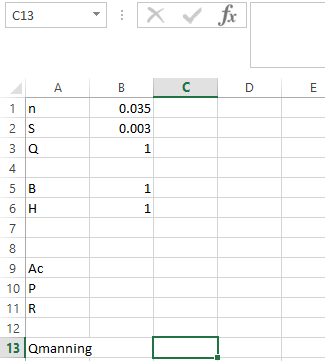
Step 2. Apply the formula in
as shown below,
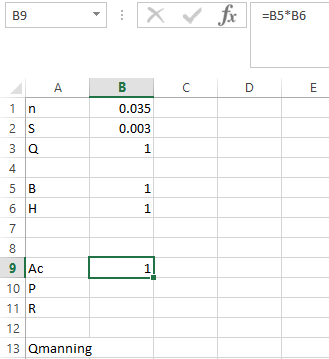
Step 3. Apply the formula in P as shown below,
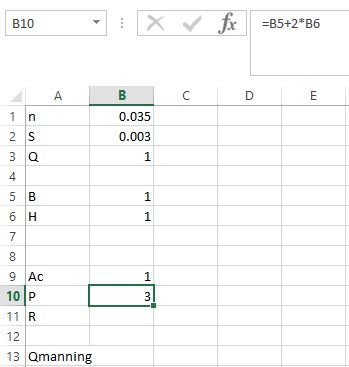
Step 4. Apply the formula in R as shown below,
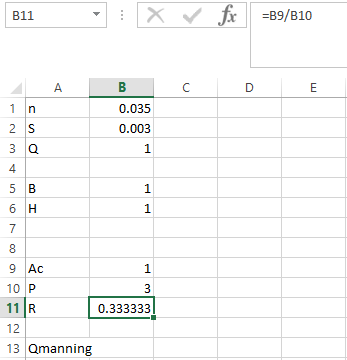
Step 5. Apply the formula in Qmanning as shown below,
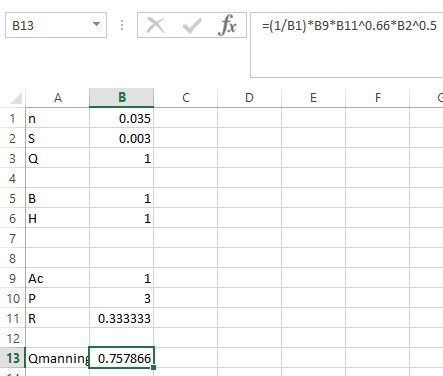
Step 6. Go to DATA and then click on Solver. This dialog box will appear.
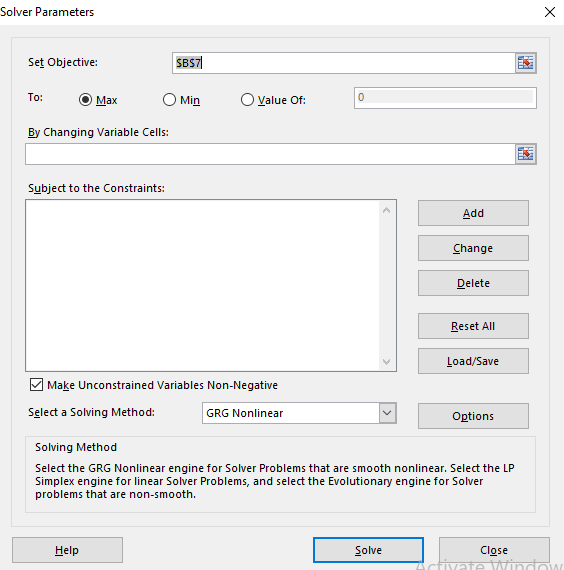
Step 7. Select the set objective, min, changing variable and then add,
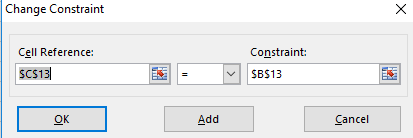
Step 8. Click OK then this dialog box appears.
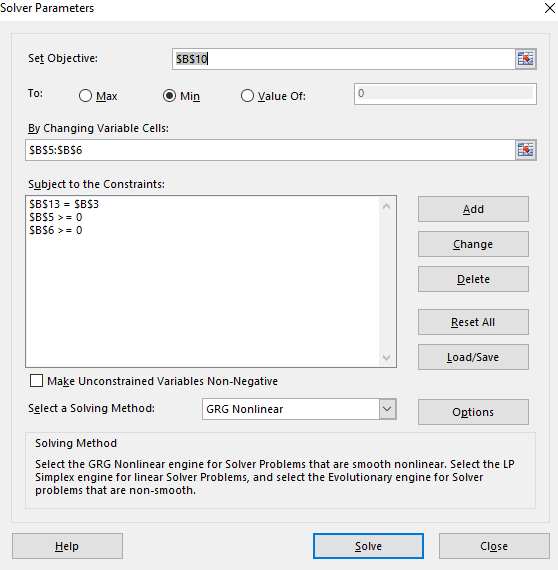
Step 9. Click on Solve and then OK.
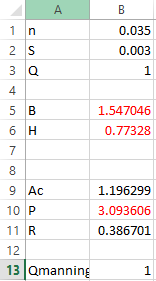
Hence, the values of
that will minimize the wetted perimeter P is
respectively.
(b)
To calculate: The values of
that will minimize the excavation cost function
is
and cost factor for lining
if the Manning equation of flow Q
can be written as
Answer to Problem 19P
Solution:
The values of
that will minimize the cost function P is
respectively.
Explanation of Solution
Given Information:
The Manning equation of flow Q
can be written as
where n is Manning roughness coefficient,
is cross-sectional are of channel
is given by
where P is wetted perimeter and it is defined by
where H is depth
and the parameters value are given as
Calculation:
Consider the function,
The constrained can be written as,
This problem can be solved out by Linear programming formulation.
To minimize the cost function with the given constraint, the excel solver can be used.
The excel solver steps are,
Step 1. Initiate quantity
and then write the parameter as shown below,

Step 2. Apply the formula in
as shown below,

Step 3. Apply the formula in P as shown below,

Step 4. Apply the formula in R as shown below,

Step 5. Apply the formula in Qmanning as shown below,

Step 6. Apply the formula in Cost as shown below,
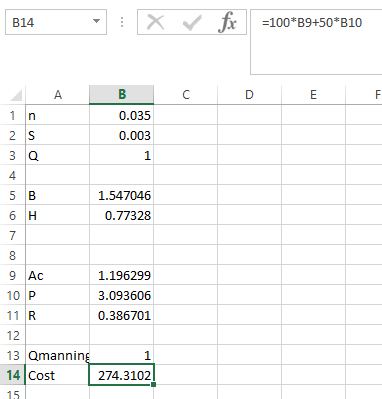
Step 7. Go to DATA and then click on Solver. This dialog box will appear.

Step 8. Select the set objective, min, changing variable and then add,

Step 9. Click OK then this dialog box appears.

Step 10. Click on Solve and then OK.
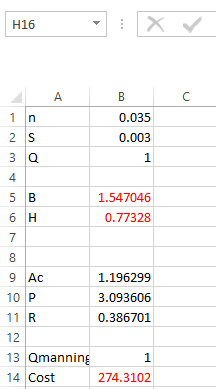
Hence, the values of
that will minimize the cost function is
respectively.
(c)
The implication of the result obtained in part (a) and part (b).
Answer to Problem 19P
Solution:
This can be interpreted that both the excavation and limiting cost can be minimized simultaneously by considering the bottom width B that is twice the length of each vertical side H.
Explanation of Solution
To interpret the result, first consider the constraint equation,
And,
On further simplification,
As
are dependent on B and H, thus both have minimized.
Thus, the excavation cost function
is minimized and as excavation cost C is directly proportional to cross-sectional area.
Hence, both the excavation and limiting cost can be minimized simultaneously by considering the bottom width B that is twice the length of each vertical side H as obtained in part (a) and (b) as
Want to see more full solutions like this?
Chapter 16 Solutions
EBK NUMERICAL METHODS FOR ENGINEERS
- practise questionarrow_forwardCan you provide steps and an explaination on how the height value to calculate the Pressure at point B is (-5-3.5) and the solution is 86.4kPa.arrow_forwardPROBLEM 3.46 The solid cylindrical rod BC of length L = 600 mm is attached to the rigid lever AB of length a = 380 mm and to the support at C. When a 500 N force P is applied at A, design specifications require that the displacement of A not exceed 25 mm when a 500 N force P is applied at A For the material indicated determine the required diameter of the rod. Aluminium: Tall = 65 MPa, G = 27 GPa. Aarrow_forward
- Find the equivalent mass of the rocker arm assembly with respect to the x coordinate. k₁ mi m2 k₁arrow_forward2. Figure below shows a U-tube manometer open at both ends and containing a column of liquid mercury of length l and specific weight y. Considering a small displacement x of the manometer meniscus from its equilibrium position (or datum), determine the equivalent spring constant associated with the restoring force. Datum Area, Aarrow_forward1. The consequences of a head-on collision of two automobiles can be studied by considering the impact of the automobile on a barrier, as shown in figure below. Construct a mathematical model (i.e., draw the diagram) by considering the masses of the automobile body, engine, transmission, and suspension and the elasticity of the bumpers, radiator, sheet metal body, driveline, and engine mounts.arrow_forward
- 3.) 15.40 – Collar B moves up at constant velocity vB = 1.5 m/s. Rod AB has length = 1.2 m. The incline is at angle = 25°. Compute an expression for the angular velocity of rod AB, ė and the velocity of end A of the rod (✓✓) as a function of v₂,1,0,0. Then compute numerical answers for ȧ & y_ with 0 = 50°.arrow_forward2.) 15.12 The assembly shown consists of the straight rod ABC which passes through and is welded to the grectangular plate DEFH. The assembly rotates about the axis AC with a constant angular velocity of 9 rad/s. Knowing that the motion when viewed from C is counterclockwise, determine the velocity and acceleration of corner F.arrow_forward500 Q3: The attachment shown in Fig.3 is made of 1040 HR. The static force is 30 kN. Specify the weldment (give the pattern, electrode number, type of weld, length of weld, and leg size). Fig. 3 All dimension in mm 30 kN 100 (10 Marks)arrow_forward
- (read image) (answer given)arrow_forwardA cylinder and a disk are used as pulleys, as shown in the figure. Using the data given in the figure, if a body of mass m = 3 kg is released from rest after falling a height h 1.5 m, find: a) The velocity of the body. b) The angular velocity of the disk. c) The number of revolutions the cylinder has made. T₁ F Rd = 0.2 m md = 2 kg T T₂1 Rc = 0.4 m mc = 5 kg ☐ m = 3 kgarrow_forward(read image) (answer given)arrow_forward
 Principles of Heat Transfer (Activate Learning wi...Mechanical EngineeringISBN:9781305387102Author:Kreith, Frank; Manglik, Raj M.Publisher:Cengage Learning
Principles of Heat Transfer (Activate Learning wi...Mechanical EngineeringISBN:9781305387102Author:Kreith, Frank; Manglik, Raj M.Publisher:Cengage Learning
